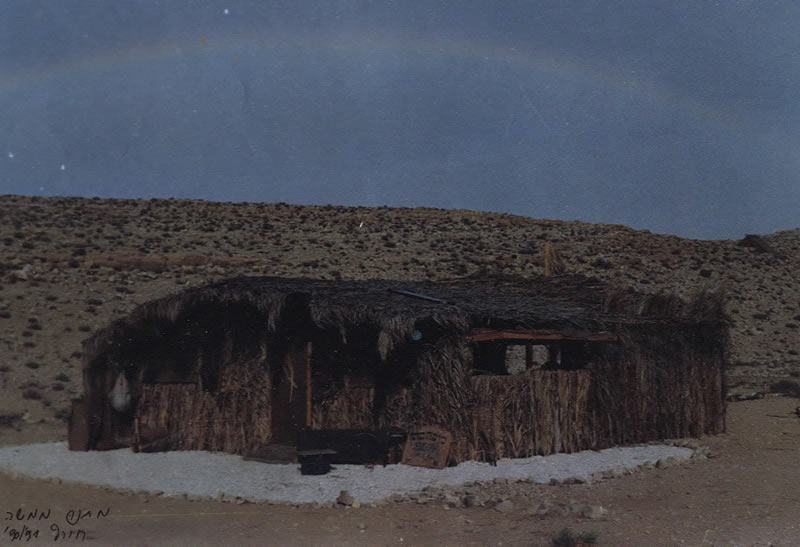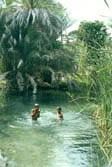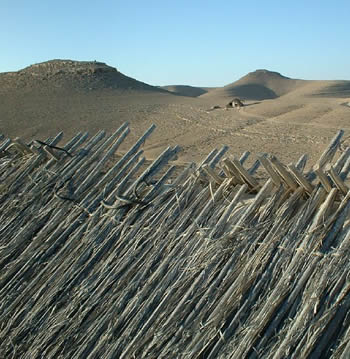|
Today - 2003_04_03
-
I found comprehensive info about Tamar, the palm tree,
which has so many meanings for me,
including the fact, that it was me,
who gave my grandson the name T, which is another form of
Tamar and today used as name for males, while Tamar is used for
females.
Since
the article in the very good website "Bridges
for Peace" is dated April 3, 2003, and might not be there
tomorrow, I'm going to quote the article in excerpts and dedicate
it to the gareed-craftsmen in Sinai and to the bamboo craftsman
Ran Lichtner in Israel.
Date Palm Tree
Of Grace And Beauty
Among the seven species of vegetation found
in Israel and listed by Moses (wheat, barley, vine, fig, pomegranate,
olive and date), the date palm holds a place of special significance
to the land and people of Israel.
... Aside from its artistic
and symbolic characteristics, the date palm has many practical
uses for food, roofing for houses, and is even a source for rope
and weaving materials...
Friend
Of Desert Dwellers
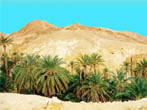 |
A
native of Israel and other areas of the Mideast, the date
palm's scientific name is Phoenix Dactylifera. Date palms
are found in groves, or as lone specimens.

|
Plantings
were often made by travelers, especially at water holes
and wells. Often, the planting was not intentional, but
the result of the date pit falling into the moist sand of
an oasis and taking root.
After all, the dried date is full of nutrition and sugar
and was easy to take as a dry fruit on long desert journeys.
Moses, in bringing the children of Israel out of Egypt,
came to a place called Elim where there were 12 wells and
70 palm trees (Ex. 15:27). Nine of the wells remain today
and the 70 palm trees have multiplied to more than 2,000.
|
|
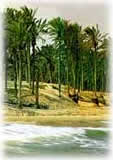
El-Arish |
The
date palm is very prolific. A female date tree may bear 200-1,000
dates each. A cluster of dates weighs up to 25 pounds (12
kg), and the annual yield of a single tree may reach 600 pounds
(270 kg). The tree begins to bear good crops during the eighth
year and is considered mature at 30 years. The trunk, marked
by the scars of fallen fronds (branches), grows about 1 foot
(30 cm) a year for the first 50 years, after which the rate
begins to decrease and few new fronds are developed. Incredibly,
date palms bear fruit annually for well over 100 years. |
Date
palms come as female and male trees. From earliest times, fertilization
of the female tree has been aided by cutting off the male flower
cluster just before the stamens ripen, then suspending them among
the flowers of the female tree. Today, machines collect pollen
from the male trees, and the pollen is then scattered by plane
or helicopter over the female trees.
Every
part of the palm is useful to those who dwell in desert lands.
The fronds are used for roofing, walls and fences, braiding
baskets, wickerwork, mats, and other woven items.
The stout mid ribs are useful
as poles for roofing and
constructing simple furniture. |
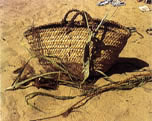 |

Ropes and cords are made from the
trunk, leaf and stalk fibers, which are very strong.
Trunks are also used as support beams.
The pits of the eaten date or the damaged or underdeveloped dates
provide fodder for camels.
As food, dates may be eaten fresh, or dried and eaten throughout
the year.
Date honey is made from the sweet thick juice of the ripened fruit.
The
Date Palm In History
Palm fronds
were used by the Israelites to construct booths in Accordance
with God's commandment to remember their deliverance from Egypt
and desert wanderings by living in a palm branch shelter during
the Feast of Tabernacles. Palm fronds are still used today during
Sukkot as roofing material for booths built on city balconies
and backyards throughout Israel.
The Jewish historian
Josephus claimed there were forests of palm trees in his time
(AD 37-95), located by the Sea of Galilee in the Jordan Valley,
as well as near Jerusalem and the Mount of Olives. One palm grove
near Jericho was described as being seven miles (10 km) long.
In the Bible, Jericho is called "the city of palm trees"
(Jud. 1:16). Phoenicia (Lebanon) also took its name from the date
palm. Though palm trees grew around Jerusalem, the hill country
of Israel was too high and too cold in winter for the palms to
bear fruit to maturity. The fruit was so poor that the Talmud
(book of Jewish law and customs) forbade its use as a temple offering
of first fruits.
Josephus records
that palm groves in and around Jerusalem were destroyed by the
Romans in AD 70 during the siege of Jerusalem. They destroyed
all vegetation in a 7 mile (10 km) radius, and a year later plowed
salt into the ground so nothing would grow there again. In the
1800s, the Turks placed a tax on trees, leading to the obliteration
of almost all trees in the land, including most of the date palms.
Date palms were reintroduced into Israel by Kibbutz Degania in
1909 at the southern end of the Sea of Galilee. There are now
over 200,000 date palms in Israel, producing around 12,000 tons
(10,886 metric tons) of dates annually.
Date
plantations are concentrated along the Syrian-African Rift Valley
from the Sea of Galilee (900 feet or 300 meters below sea level),
to Jericho along the Dead Sea (1,200 feet or 400 meters below
sea level), and to Eilat on the Red Sea in the south. This valley
is the lowest area on earth and is typified by a hot dry climate
and an abundance of underground water, perfect conditions for
growing extremely high quality dates.
Spiritual
And Symbolic Significance
The date palm
(Hebrew "tamar") means tall and willowy. Tamar, suggesting
grace and beauty, was the name given to several Hebrew women.
The sword-shaped, unopened frond growing from the heart of the
date palm is called the lulav. During the Feast of Tabernacles
it is waved (along with the willow, myrtle and citron) by Jews
toward the four corners of the earth
Jesus rode from
Bethphage into Jerusalem, multitudes waved palm branches and laid
them on the road before Him. In so doing, they were not only giving
Him honor as a coming king, but making an enormous symbolic political
declaration before the Romans about the hoped for independence
of the Jews from Rome under the rule of their Messiah. Without
the palm branches, it would have merely looked like a noisy mob.
It was the palm branches that symbolically proclaimed the majesty
of the occasion.
Ornately carved date palms adorned the inner walls of Solomon's
Temple, symbolizing the Sanctuary of God's Presence as the spiritual
oasis in man's life on earth. An oasis is a tranquil retreat,
a place of rest and refreshment, a joy and relief to sojourners
of the desert to find palm trees beckoning to their source of
fresh water, offering shade and plentiful fruit.
The Psalmist
used the date palm symbolically of the righteous. Verses
from |
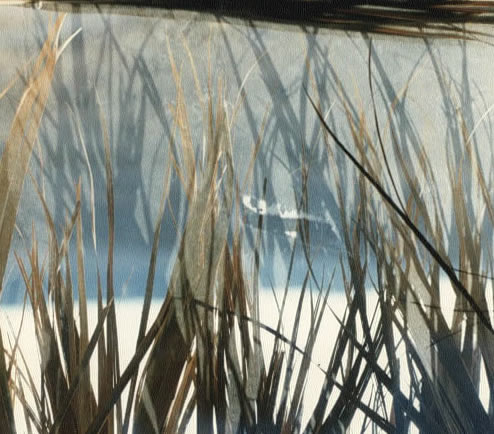
Michal Dror, the artist, photographed
and painted numerous aspects of palm fronds
like those in front of the window of the cabin in which she
lived
while working as hostess in the Succah, in 1993
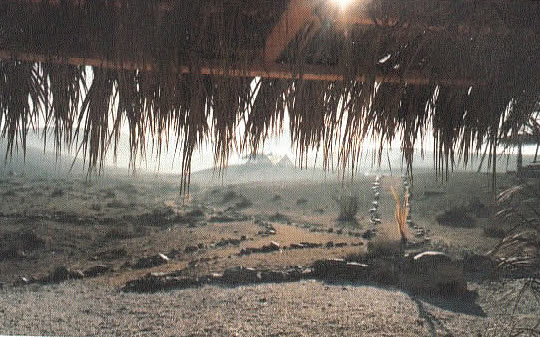
Morning view of the Tent
of Appointment from under the "veranda" of the
Abraham's succah.
"The stout
mid ribs
are useful
as poles
for roofing and
constructing simple furniture."
The latter is called the craft of "gareed" in
Sinai.
To my regret
I can't find any illustration, nor did my own design of
a "closet bench" , intended for the back corner
of the pyramidal tent ever come into being for
reasons still painful... |
|
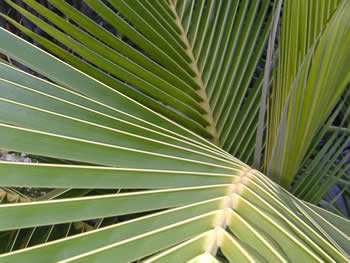
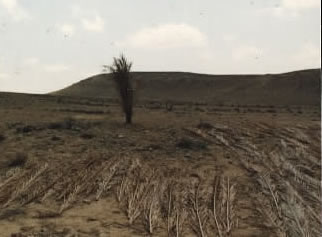
Palm Fronds, gathered 120 km further south, drying in the Succah
area

"The
righteous shall flourish like the palm tree...
they shall still bring forth fruit in old age."
Psalm
92
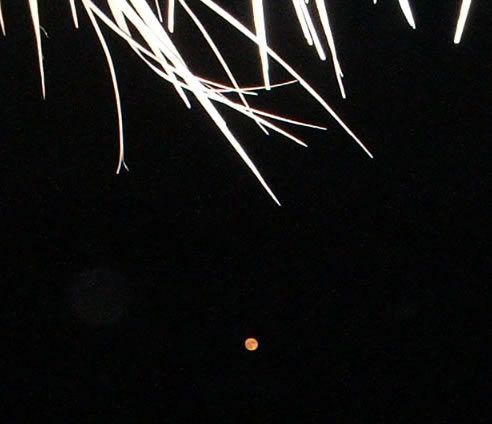
|
